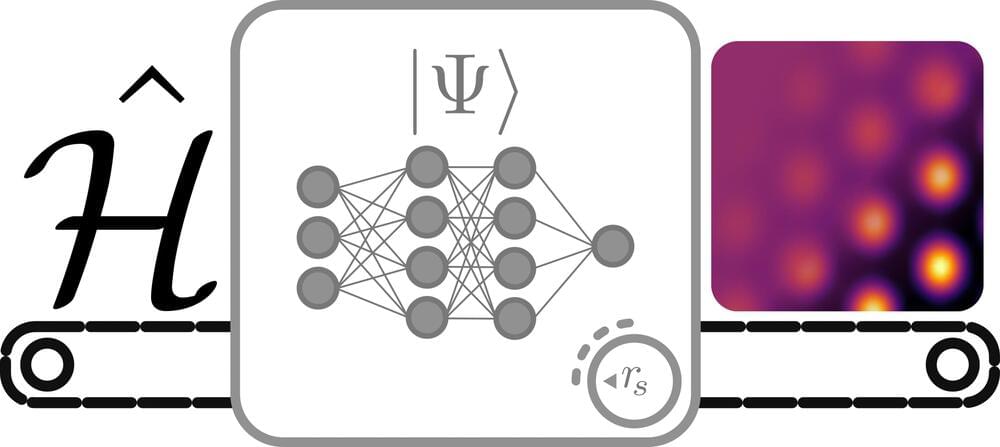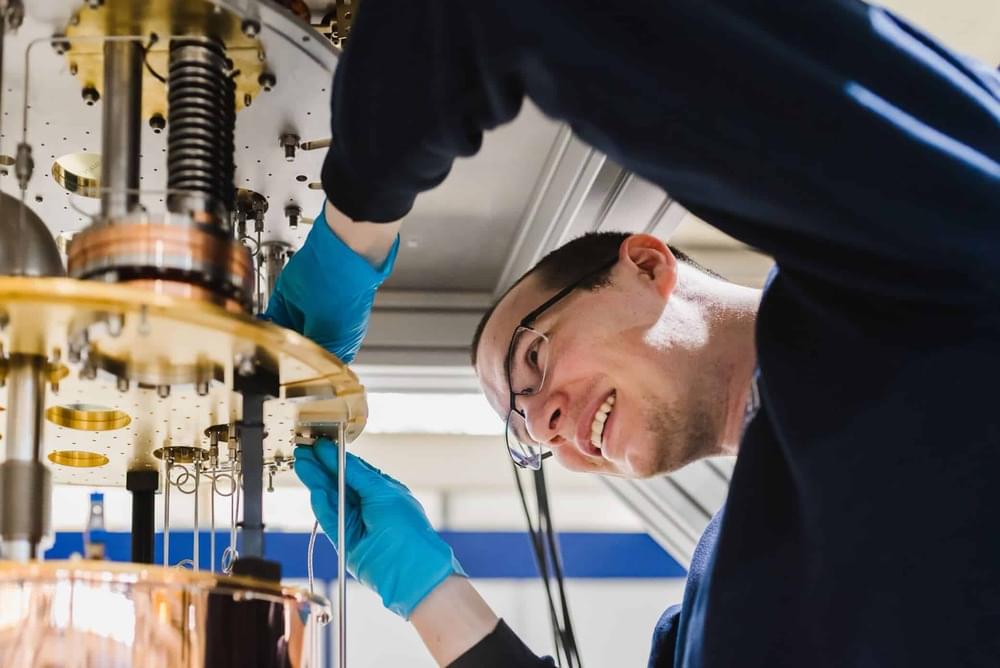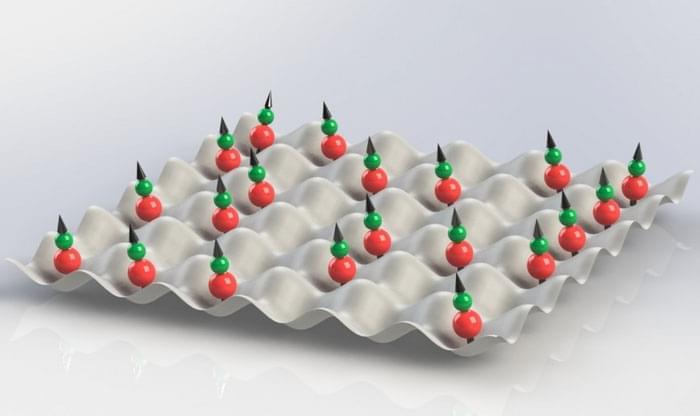Individual atoms trapped by optical ‘tweezers’ are emerging as a promising computational platform.



Brian Greene is a theoretical physicist. Please support this podcast by checking out our sponsors:
- The Prisoner Wine Company: https://theprisonerwine.com/lex to get 20% off & free shipping.
- Blinkist: https://blinkist.com/lex and use code LEX to get 25% off premium.
- LMNT: https://drinkLMNT.com/lex to get free sample pack.
- BetterHelp: https://betterhelp.com/lex to get 10% off.
- NI: https://www.ni.com/perspectives.
EPISODE LINKS:
Brian’s Twitter: https://twitter.com/bgreene.
Brian’s Website: http://www.briangreene.org/
Until the End of Time (book): https://amzn.to/2XuqXUi.
PODCAST INFO:
Podcast website: https://lexfridman.com/podcast.
Apple Podcasts: https://apple.co/2lwqZIr.
Spotify: https://spoti.fi/2nEwCF8
RSS: https://lexfridman.com/feed/podcast/
Full episodes playlist: https://www.youtube.com/playlist?list=PLrAXtmErZgOdP_8GztsuKi9nrraNbKKp4
Clips playlist: https://www.youtube.com/playlist?list=PLrAXtmErZgOeciFP3CBCIEElOJeitOr41
OUTLINE:
0:00 — Introduction.
0:27 — Entropy.
8:35 — Consciousness.
24:54 — Quantum gravity.
28:14 — String theory.
41:41 — Time.
54:13 — Free will.
58:36 — Emergence and complexity.
1:05:48 — The Big Bang.
1:18:47 — Extraterrestrial life.
1:29:09 — Space exploration.
1:37:07 — Fear of death.
SOCIAL:
- Twitter: https://twitter.com/lexfridman.
- LinkedIn: https://www.linkedin.com/in/lexfridman.
- Facebook: https://www.facebook.com/lexfridman.
- Instagram: https://www.instagram.com/lexfridman.
- Medium: https://medium.com/@lexfridman.
- Reddit: https://reddit.com/r/lexfridman.
- Support on Patreon: https://www.patreon.com/lexfridman

Architectures based on artificial neural networks (ANNs) have proved to be very helpful in research settings, as they can quickly analyze vast amounts of data and make accurate predictions. In 2020, Google’s British AI subsidiary DeepMind used a new ANN architecture dubbed the Fermionic neural network (FermiNet) to solve the Schrodinger equation for electrons in molecules, a central problem in the field of chemistry.
The Schroedinger equation is a partial differential equation based on well-established theory of energy conservation, which can be used to derive information about the behavior of electrons and solve problems related to the properties of matter. Using FermiNet, which is a conceptually simple method, DeepMind could solve this equation in the context of chemistry, attaining very accurate results that were comparable to those obtained using highly sophisticated quantum chemistry techniques.
Researchers at Imperial College London, DeepMind, Lancaster University, and University of Oxford recently adapted the FermiNet architecture to tackle a quantum physics problem. In their paper, published in Physical Review Letters, they specifically used FermiNet to calculate the ground states of periodic Hamiltonians and study the homogenous electron gas (HEG), a simplified quantum mechanical model of electrons interacting in solids.

Over eighty years ago, Rabi oscillations were proposed to describe the strong coupling and population transfer in a two-level quantum system exposed to an oscillatory driving field. As compared to atoms, molecules have an extra degree of vibration, which adds an additional knob to the Rabi oscillations in light-molecule interactions. However, how such a laser-driven Rabi oscillation during the stretching of molecular bonds determines the kinetic energy release (KER) spectrum of dissociative fragments is still an open question.
In a new article published in Light: Science & Applications, a joint team of scientists, led by Professor Feng He from Shanghai Jiao Tong University and Professor Jian Wu from East China Normal University has investigated Rabi oscillations in a stretching molecule and discovered the strong-field-induced dissociation dynamics beyond the well-accepted resonant one-photon dissociation scenario. During the dissociation of the simplest molecular ion of H2+, coupled with the laser field, the electron hops between the 1sσg and 2pσu states, forming the Rabi oscillations.
The ionization-created nuclear wave packet (NWP) may propagate alternatively along the two potential energy curves towards a larger internuclear distance monotonically, termed as the rolling process, or may propagate outwards along the 2pσu curve followed by the inward propagation in the 1sσg curve and then be relaunched to 2pσu state again followed by subsequent dissociation, termed as the looping process. The rolling and looping dissociation pathways lead to different KERs of the ejected dissociative fragments, which have been verified by comparing experimental measurements with quantum simulation results.

The emerging quantum technology industry offers a dynamic career pathway for creative and adaptable physical scientists, as Stuart Woods of Oxford Instruments NanoScience explains.
As quantum technology companies shift gears to translate their applied research endeavours into commercial opportunities – at scale – they’re going to need ready access to a skilled and diverse quantum workforce of “all the talents”. A case study in this regard is Oxford Instruments NanoScience, a division of parent group Oxford Instruments, the long-established UK provider of specialist technologies and services to research and industry.
The NanoScience business unit, for its part, designs and manufactures research tools to support the development, scale-up and commercialization of next-generation quantum technologies. Think cryogenic systems (operating at temperatures as low as 5 mK) and high-performance magnets that enable researchers to harness the exotic properties of quantum mechanics – entanglement, tunnelling, superposition and the like – to yield practical applications in quantum computing, quantum communications, quantum metrology and quantum imaging.
The michael shermer show # 294
What is time? Does the past still exist? How did the universe begin and how will it end? Do particles think? Was the universe made for us? Why doesn’t anyone ever get younger? Has physics ruled out free will? Will we ever have a theory of everything? According to Sabine Hossenfelder, it is not a coincidence that quantum entanglement and vacuum energy have become the go-to explanations of alternative healers, or that people believe their deceased grandmother is still alive because of quantum mechanics. Science and religion have the same roots, and they still tackle some of the same questions: Where do we come from? Where do we go to? How much can we know? The area of science that is closest to answering these questions is physics. Over the last century, physicists have learned a lot about which spiritual ideas are still compatible with the laws of nature. Not always, though, have they stayed on the scientific side of the debate.
Shermer and Hossenfelder also discuss: theories of everything • quantum flapdoodle • Is math all there is? Is math universal? • Uniformitarianism and the laws of nature • theories of aging • Emergent properties, or why we are not just a bag of atoms • Is knowledge predictable? • Free will and determinism from a physicist’s perspective • Do copies of us exist? Could they ever? • Consciousness and computability • Does the universe think? • Why is there something rather than nothing? • What is the purpose of life, the universe, and everything?
Sabine Hossenfelder is a research fellow at the Frankfurt Institute for Advanced Studies, Germany, and has published more than eighty research articles about the foundations of physics, including quantum gravity, physics beyond the standard model, dark matter, and quantum foundations. She has written about physics for a broad audience for 15 years and is the creator of the popular YouTube channel “Science without the Gobbledygook.” Her writing has been published in New Scientist, Scientific American, the New York Times, and the Guardian (London). Her first book, Lost in Math: How Beauty Leads Physics Astray, appeared in 2018.
SUPPORT THE PODCAST
If you enjoy the podcast, please show your support by making a $5 or $10 monthly donation.
https://www.skeptic.com/donate/
SPONSOR


The performance of some quantum technologies could be boosted by exploiting interactions between nitrogen-vacancy (NV) centres and defects on the surface of diamond – according to research done by two independent teams of scientists in the US.
NV centres in diamond have emerged as a promising solid-state platform for quantum sensing and information processing. They are defects in the diamond lattice in which two carbon atoms are replaced with a single nitrogen atom, leaving one lattice site vacant. NV centres are a two-level spin system into which quantum information can be written and read out using laser light and microwaves. An important property of NV centres is that once they have been put into a specific quantum state, they can remain in that state for a relatively long “coherence” time – which makes them technologically useful.

Physicists are increasingly using ultracold molecules to study quantum states of matter. Many researchers contend that molecules have advantages over other alternatives, such as trapped ions, atoms or photons. These advantages suggest that molecular systems will play important roles in emerging quantum technologies. But, for a while now, research into molecular systems has advanced only so far because of long-standing challenges in preparing, controlling and observing molecules in a quantum regime.
Now, as chronicled in a study published in Nature (“Probing site-resolved correlations in a spin system of ultracold molecules”), Princeton researchers have achieved a major breakthrough by microscopically studying molecular gases at a level never before achieved by previous research. The Princeton team, led by Waseem Bakr, associate professor of physics, was able to cool molecules down to ultracold temperatures, load them into an artificial crystal of light known as an optical lattice, and study their collective quantum behavior with high spatial resolution such that each individual molecule could be observed.
“We prepared the molecules in the gas in a well-defined internal and motional quantum state. The strong interactions between the molecules gave rise to subtle quantum correlations which we were able to detect for the first time,” said Bakr.